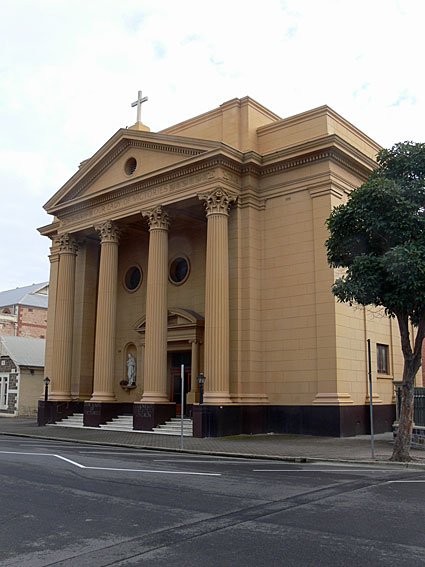
Our Lady of Victories Church : exterior from the south-east
[Photograph by John Maidment (13 June 2012)]

Our Lady of Victories Church : exterior from the south-east
[Photograph by John Maidment (13 June 2012)]
Historical and Technical Documentation by David Shield
© OHTA 2012 (last updated June 2012)
The present Our Lady of Victories Church, Glenelg, replaced an earlier church opened in 1869.1 The foundation stone of the present church was laid on 3 October 1926. A description of the church appeared earlier in The Register as follows:
A NEW CHURCH-ROMAN CATHOLIC PROGRESS AT GLENELG.
ST. MARY'S CHURCH, GLENELG. PERSPECTIVE DRAWING OF THE PROPOSED NEW ROMAN CATHOLIC CHURCH OF ST. MARY'S, HIGH STREET, GLENELG.A contract has been finalized for the erection of a new church building at High street, Glenelg, for the Roman Catholic community of that district. As regards church architecture in South Australia, a distinct departure has been decided upon, and after careful consideration the architects (Messrs. Garlick & Jackman) have adopted the Italian Renaissance as their basis, and the illustration depicts a noble edifice of unique and pleasing, design. The purely classical theme will be followed throughout and, judging by the reproduction, there should be no doubt as to the result. The growing need of a large church at Glenelg has been exercising the minds of members of the church for some considerable time, and they are very grateful for the enterprise of Father Murphy, the priest in charge, and the committee, who have made it possible to erect the new edifice. The seating accommodation, exclusive of the choir gallery, will be 600. Polished panelled blackwood has been decided upon for the seating, communion rail, and other woodwork throughout. The whole of the walls internally will be finished in white plaster, and all the mouldings will be of strictly classical design. The ceiling will be heavily panelled in fibrous plaster of special detail. The dimensions of the church proper will be 98 ft. by 50 ft., with a height of 37 ft. Provision has been made for further necessary accommodation, such as sanctuary, confessionals, and a special chapel for the nuns (whose school adjoins). The floor of the sanctuary it is proposed to finish in Terrazzo, of a special design with white marble steps to both, sanctuary and leading to the altar. Externally the whole will be finished in cement, closely resembling buff freestone in colour and texture. Some idea can be obtained as to the height by comparing the figures shown in the foreground. Special care has been taken as regards ventilation. The total cost of the complete building will be approximately £20,000, and it is expected that it will be finished in 18 months. The following other firms are directly responsible for the different works: — Messrs. Webber and Williams contractors: Mr. H. J. Speck, mason; Mr. J. G. Harris, fibrous plasterer; and Messrs. Newton, McLaren, Limited, electric lighting and power installation.2
The new church was blessed and opened on the afternoon of Sunday 20 November 1927, and it was announced that there would be 'a recital on the new organ immediately before devotions':3
NEW CHURCH OF OUR LADY OF VICTORIES, GLENELG. Solemn Blessing and Opening on Sunday Next, November 20, AT 3 PM. BY HIS GRACE. THE ARCHBISHOP OF ADELAIDE assisted by their Lordships the Bishops of Ballarat and Port Augusta.
Organ Recital at 7.15 p.m.
Evening devotions consisting of Rosary Sermon, by the Bishop of Port Augusta, and Pontifical Benediction by the Archbishop of Adelaide, at 7.30pm.4
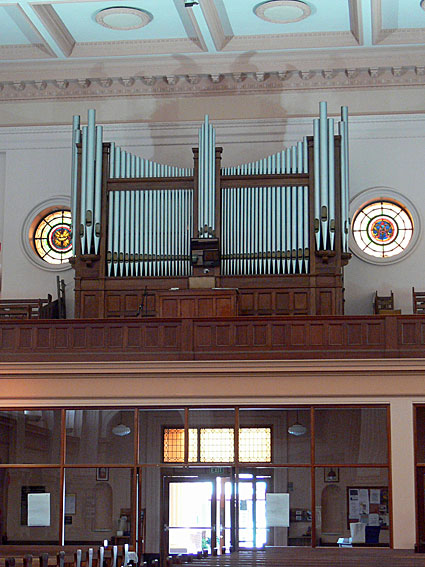
Our Lady of Victories Church : organ viewed from sanctuary
[Photograph by John Maidment (13 June 2012)]
The organ was built in 1927 by J.E. Dodd of Adelaide at a cost of £1,260.5 Located in the west gallery of the church, with a characteristic Dodd case incorporating signature three-pipe towers, it enjoys excellent acoustics, and has been preserved essentially in its original condition and is in very good mechanical condition. It is of considerable significance as a rare example of a Dodd organ built in the 1920s to remain intact, preserving its original action, console, wind system and pipework, and notable for the solidity and overall excellence of its construction. The style of console is similar but less elaborate version of that on the 1912 Dodd organ at St Thomas-the-Apostle Catholic Church, Claremont, WA in its stop layout and use of drawstops with endolithic engraving.
| GREAT Open Diapason Clarabel Dulcissima Principal Flute de Orchestre SWELL Lieblich Bourdon Violin Diapason Hohl Flute Viole di Gamba Vox Angelica Octave Diapason Oboe Tremulant PEDAL [Major Bass] Sub Bass Echo Bourdon Bass Flute COUPLERS Swell to Great Swell to Pedal Great to Pedal Swell Super Swell Sub Swell to Great Super Swell to Great Sub |
8 8 8 4 4 16 8 8 8 8 4 8 [16] 16 16 8 |
A TC B A B |
[metal harmonic flute] [by hitchdown pedal] [prepared for] |
Tubular-pneumatic action
Compass 61/30.
3 thumb pistons to Great
3 thumb pistons to Swell
3 hitchdown blind general combination pedals
Balanced swell pedal
Detached drawstop console.6
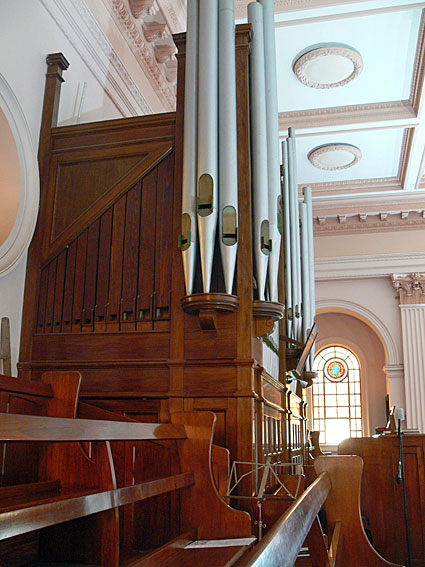
Our Lady of Victories Church : organ viewed from side of gallery
[Photograph by John Maidment (13 June 2012)]
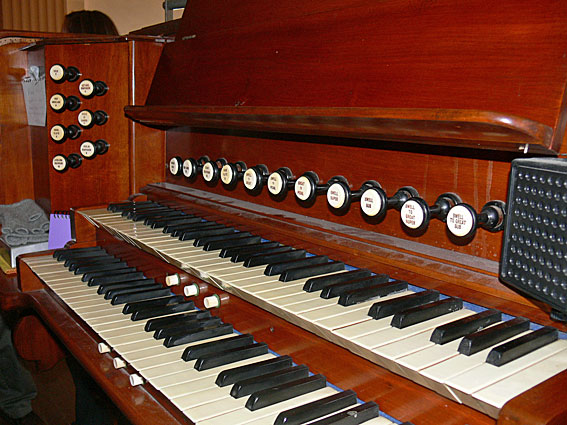
Our Lady of Victories Church : organ console
[Photograph by John Maidment (13 June 2012)]

Our Lady of Victories Church : Great pipework
[Photograph by John Maidment (13 June 2012)]
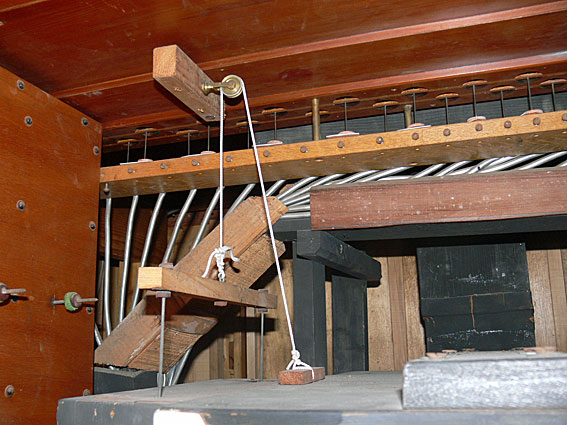
Our Lady of Victories Church : Great reservoir and under actions
[Photograph by John Maidment (13 June 2012)]
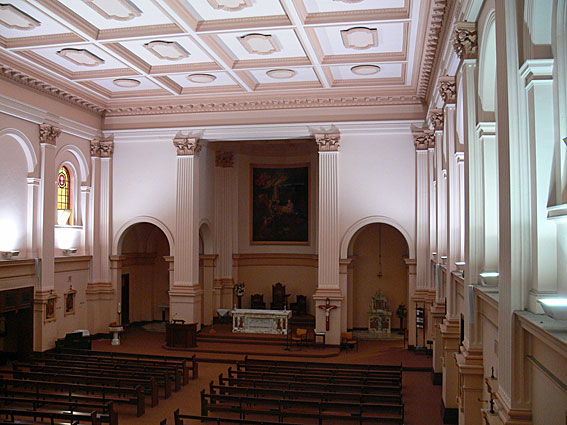
Our Lady of Victories Church : interior viewed from organ gallery
[Photograph by John Maidment (13 June 2012)]
_____________________________________________________________________
1 The South Australian Advertiser (31 March 1869), p. 2; South Australian Register (21 June 1869), p. 3.
2 The Register (15 July 1926), p. 12.
3 The Advertiser (5 November 1927), p. 8.
4 The Advertiser (17 November 1927), p. 3.
5 J.E. Dodd Ledger 1925, p. 60.
6 Specification noted by David Shield, March 1993, with additional material by John Maidment, June 2012.